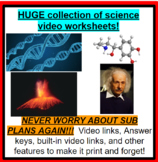Mystery of Matter: Out of Thin Air - GREAT SUB PLANS!
Huge House of Science
256 Followers
Grade Levels
5th - 12th
Subjects
Resource Type
Standards
NGSSHS-PS1-8
NGSSHS-PS1-1
NGSSHS-PS1-4
NGSSHS-PS1-6
NGSSMS-PS1-4
Formats Included
- Word Document File
Pages
2 pages
Huge House of Science
256 Followers
What educators are saying
Great for emergency sub plans. I used this as a backup during my maternity leave if the sub finished early or needed a movie day.
Also included in
- Actual comments from my students:"Mr. Hess! This is sooooo coooool!""They actually did that?!""Woah!""Can I watch this at home?"The Mystery of Matter is a fantastic three part documentary about the history of the study of the atom and the periodic table of elements. The documentary is nearly threePrice $4.00Original Price $4.50Save $0.50
- This massive collection of video worksheets covers a number of NGSS standards. Each worksheet has a direct link to the video file built in to the worksheet, each worksheet has either fill in the blank or multiple choice question and EVERY worksheet has an answer key to go with it. Fool proof sub pPrice $37.10Original Price $53.00Save $15.90
- This collection of worksheets has direct links to videos that cover a number of physical science topics. The worksheets are multiple choice or fill in the blank and every single one includes an answer key.Price $14.70Original Price $21.00Save $6.30
- Price $36.80Original Price $46.00Save $9.20
Description
Actual comments from my students:
- "Mr. Hess! This is sooooo coooool!"
- "They actually did that?!"
- "Woah!"
- "Can I watch this at home?"
The Mystery of Matter is a fantastic three part documentary about the history of the study of the atom and the periodic table of elements. The video is nearly an hour long, and makes for an EXCELLENT last minute substitute lesson plan. The first video in the series, Out of Thin Air, looks at the earliest stages of research into the atom. It not only helps the viewer understand parts of atomic theory, but also wonderfully illustrates how the study of matter evolved over time.
This worksheet includes:
- 15 multiple choice questions
- Answer key
- Link to video
Interested in the worksheet for part two and part three?
Total Pages
2 pages
Answer Key
Included
Teaching Duration
1 hour
Report this resource to TPT
Reported resources will be reviewed by our team. Report this resource to let us know if this resource violates TPT’s content guidelines.
Standards
to see state-specific standards (only available in the US).
NGSSHS-PS1-8
Develop models to illustrate the changes in the composition of the nucleus of the atom and the energy released during the processes of fission, fusion, and radioactive decay. Emphasis is on simple qualitative models, such as pictures or diagrams, and on the scale of energy released in nuclear processes relative to other kinds of transformations. Assessment does not include quantitative calculation of energy released. Assessment is limited to alpha, beta, and gamma radioactive decays.
NGSSHS-PS1-1
Use the periodic table as a model to predict the relative properties of elements based on the patterns of electrons in the outermost energy level of atoms. Examples of properties that could be predicted from patterns could include reactivity of metals, types of bonds formed, numbers of bonds formed, and reactions with oxygen. Assessment is limited to main group elements. Assessment does not include quantitative understanding of ionization energy beyond relative trends.
NGSSHS-PS1-4
Develop a model to illustrate that the release or absorption of energy from a chemical reaction system depends upon the changes in total bond energy. Emphasis is on the idea that a chemical reaction is a system that affects the energy change. Examples of models could include molecular-level drawings and diagrams of reactions, graphs showing the relative energies of reactants and products, and representations showing energy is conserved. Assessment does not include calculating the total bond energy changes during a chemical reaction from the bond energies of reactants and products.
NGSSHS-PS1-6
Refine the design of a chemical system by specifying a change in conditions that would produce increased amounts of products at equilibrium. Emphasis is on the application of Le Chatelier's Principle and on refining designs of chemical reaction systems, including descriptions of the connection between changes made at the macroscopic level and what happens at the molecular level. Examples of designs could include different ways to increase product formation including adding reactants or removing products. Assessment is limited to specifying the change in only one variable at a time. Assessment does not include calculating equilibrium constants and concentrations.
NGSSMS-PS1-4
Develop a model that predicts and describes changes in particle motion, temperature, and state of a pure substance when thermal energy is added or removed. Emphasis is on qualitative molecular-level models of solids, liquids, and gases to show that adding or removing thermal energy increases or decreases kinetic energy of the particles until a change of state occurs. Examples of models could include drawings and diagrams. Examples of particles could include molecules or inert atoms. Examples of pure substances could include water, carbon dioxide, and helium.








